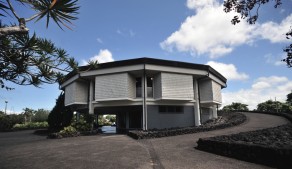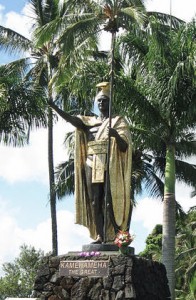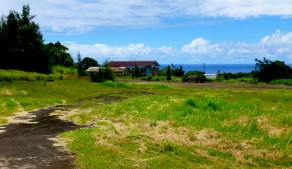
Mike Marshall and I arrived at Wailoa Center, which is located in the center of Hilo’s largest city park, which is traverse by a freshwater lagoon. The parkland had been cleared by a tsunami in May 1960. Instead of rebuilding, the area was set aside for public recreation as a memorial to the more than sixty people who lost their lives to the disaster. At the north end of Wailoa River State Park is a fourteen-foot statue of King Kamehameha I, who is credited with Hawaiian unification. One guidebook claims that the statue had been lost at sea and recovered many years later; while other sources report that it was commissioned to greet guests arriving at a resort on Kauai, where the locals objected on the grounds that the first Kamehameha never took control of their island.
Wailoa Center itself is an octagonal two-story pavilion embraced on five sides by an inclined base of volcanic rock one-story high around which ascends a ramp to provide access to people with disabilities. Mike and I carried the three drawings into the building, which like many buildings on the island is open to the elements. As we entered her office, Mike introduced me to Codie, the center’s director. A lively woman with a mane of white hair wearing a blue-and-white Hawaiian shirt, she sat in an office chair with one foot propped on a pile of towels atop her desk, nursing a recent injury. Pardon me for not getting up, she said, I’m just waiting for this thing to stop bleeding. I reached across the desk and shook her hand.
We all commiserated about the censorship of the exhibition and Mike promised to organize a Banned show at the university as a rebuttal to the nude exclusion by the Codie’s bosses. Popular images of Hawai’i have been shaped by Elvis movies, Hula girls, surfers as a swinging tropical backdrop to television crime shows. The reality is far from the myth. Hilo had been a village that grew into a government center under the rule of Kamehameha I. Soon after, missionaries and Yankee whalers arrived to save souls and hunt the waters off the Kohala and Hamakua coasts.
The second Kamehameha abolished the traditional Hawaiian religion and its system of Kapu (taboos) in favor of Christianity. The community today is full of deeply religious people whose view of nudity no doubt is based on Congregationalist fire and brimstone values, at odds with the rich artistic heritage of Catholicism. The irony of course is that prior to Western contact, indigenous people preferred light raiment. Zealous missionaries had taught them to regard the body as sinful.
I asked to see the vitrines in which my sketchbooks would be exhibited and was shown two bulky wooden fixtures that might have seen use in the S.H. Kress store, or one of the other former Hilo retailers. Both were accessible by sliding back-panels, but not secured by locks. How would these be secured, I asked.
Jeff—the installer and preparator whose sartorial appearance was similar to my Pakalana landlord—explained that the pieces could be placed back-to-back, which would hinder anyone trying to get into them. This did not bode well. When Codie told me that I would have to sign a waiver in order for the books to be included in the exhibition I decided to hang onto them. Instead I gave her a copy of Mapping and Mobility—the book published by New Arts Projects in Connecticut. Painter and web designer Graham White had already sent her an animation of several dozen of my sketchbook page spreads, which was running on a large-format television screen in the gallery upstairs. I apologized, explaining that if no one was willing to take responsibility for my work, that I would be forced to do so myself.
I drove Mike back to Building 395 and then collected Kathie, heading off to Banyan Drive for lunch at the Hilo Bay Café. Reputed as one of the finer bistros in town, it stands atop a central mechanicals column like any New York skyscraper, the edges supported by a concrete Sonotube colonnade, presumably in case of tsunami. A lanai faces the bay, looking across the green margins of Liliukalani Park. The building was an open-air structure like many on the island. The wait-staff was young and attractive. Salads and fish tacos were presented with spare artistry, garnished with small blossoms and sprigs of herbs, on large white plates. Dinner would have required a more significant investment. Following our repast we drove along Banyan Drive, past the Hilo Hawaiian hotel—a 1960s modern high-rise with balconies for every room. Some of the other hotels looked as if they had seen better days. Debouching from the lush foliage we drove into the seaport zone full of low-rise industrial buildings, many thirsting for a new coat of paint. Lashed to the pier was a massive ship of the Norwegian Cruise Line. Every Tuesday one of these leviathans calls at Hilo, disgorging its passengers who spend the day in the stores, restaurants and open-air markets in downtown Hilo, roughly a mile away.
South of the port along the bay we passed a few buildings probably purpose built as hotels but now serving as lower-income condos and apartments. Farther on we drove into a forested area. Bathers frolicked in tidal pools. The road surface changed from tarmac to gravel and then to dirt before it disappeared into a tangle of rutted swaths that approached Richardson Beach. A wall of volcanic rock divided the thoroughfare from the rugged beach. On it sat a Hawaiian couple; a youngish man covered in tattoos and a heavy-set woman a few years younger than he. A middle-aged Asian woman marched across the parking area from her car toward the water. Here and there a few rough characters seemed to be minding their own business.
We drove back to the print shop, where I received from Jonathan Goebel a copper plate equipped with a hard ground, a scribe, burin and burnisher.Worried about leaving the plate in the car during the heat of the day, we made a pit stop at Pakalana before conducting a reconnaissance along the Hamakua Coast as far north as Laupehoehoe.
Returning to our accommodations we showered, changed and went to dinner at Café Pesto—Hilo’s other fine dining establishment. The menu was eclectic, vaguely Italian. The wait-staff was much like that at the Hilo Bay Café. Perhaps many of them were university students. I was stunned at some of the wine prices but jumped at a glass of Lagavullin 16-year old for ten-dollars. Thus came to an end the month of June.


 Facebook
Facebook Twitter
Twitter Linkedin
Linkedin